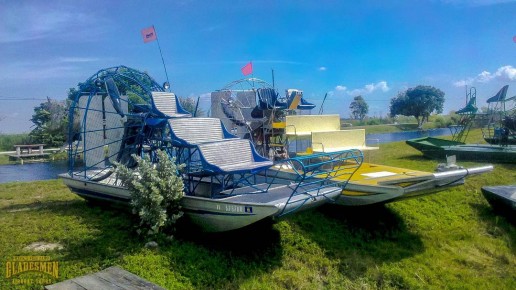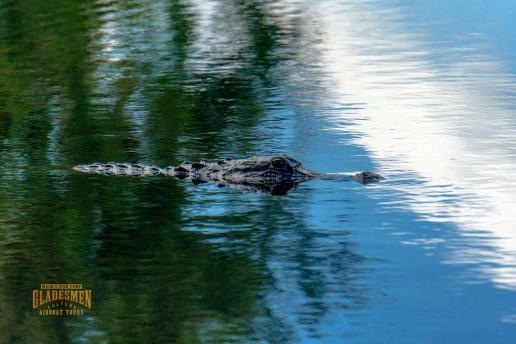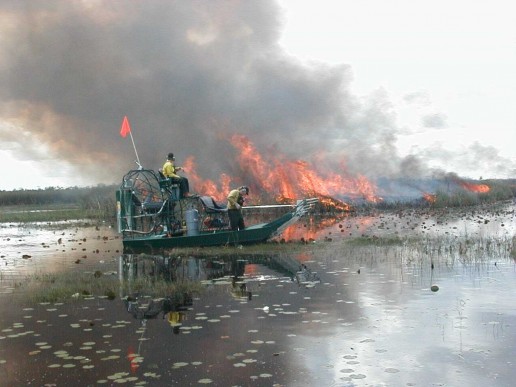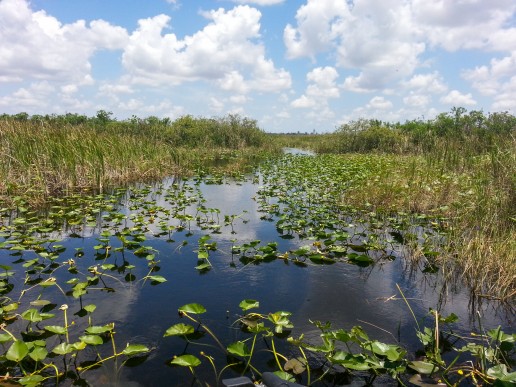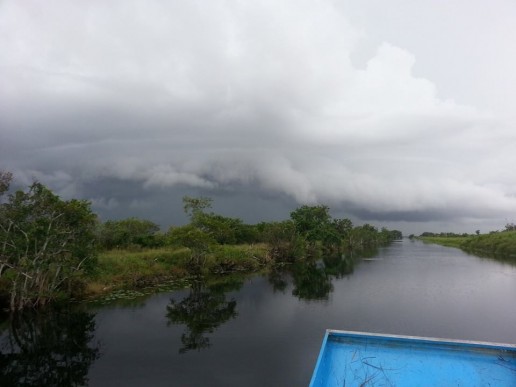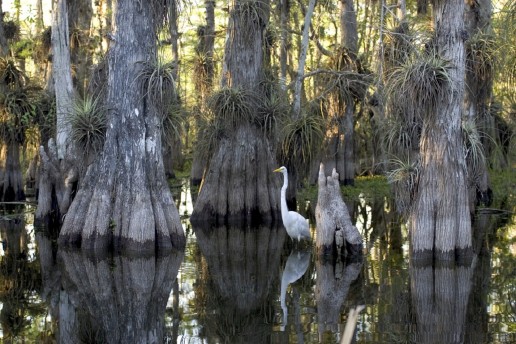Airboat Safety at Mack’s Fish Camp
Airboats are easily the best way to get around in the Everglades. Not to mention the most fun. They can take you across the countless miles of wetlands and bring you up close to wildlife. But one may have safety concerns about the airboat ride itself. Accidents can happen, but at Mack’s Fish Camp we know that good airboat safety can help plan for many and prevent most.
For generations of Gladesmen, airboats have been a large part of our thriving out here for as long as we have. We are grateful to be able to show people from all over the world what makes the Everglades so special. But, we also take price in doing so safely.
Before an airboat tour, we advise our passengers on safety precautions before even leaving the dock. Here are some of the airboat safety guidelines airboats must follow, per the Florida Department of Environmental Services. They were designed to help offer a safer experience on an airboat ride in the Everglades.
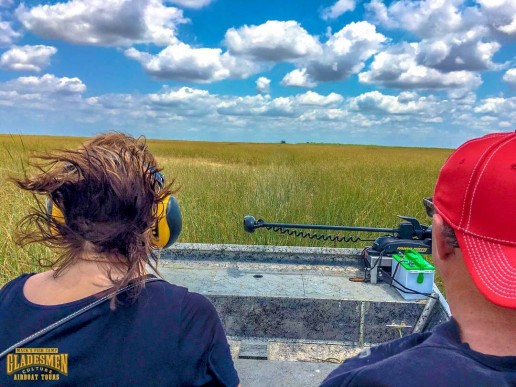
Preoperative Checklist
The airboat captain inspects the vessel to make sure the engine and propeller aren’t damaged and in working order. This helps to prevent both injury and mechanical breakdown.
Safety Equipment
A first-aid kit, eye and ear protection, drinking water, a B-1 type approved fire extinguisher, and a cell phone in a buoyant, waterproof case must all be on an airboat, in keeping with many requirements for recreational vessels.
Mind the Propeller
No one is permitted near the propeller. Loose clothing and items could get caught in it, resulting bodily injury to the person and damage to the airboat. To avoid this, all items aboard must be secured.
Navigation
We are trained and well-skilled in navigating and maneuvering any potential obstacles, blind spots, or tight areas. Having lived here our entire lives, we’re very familiar with the fluctuating water levels of the Everglades and the area itself. We can safely avoid getting stuck in stuck, but also know where we are in case of an emergency.
Weather
The subtropical climate of Florida can make for volatile weather conditions, such as heavy thunderstorms, high winds and lightning. We stay mindful of the weather throughout the day, acting accordingly with any changes. In case of fog, airboats are operated with strobes for increased visibility of the craft. During or pending any inclement weather like lightning or heavy rain and wind, our airboats remain docked.
Preventative Maintenance
Every week we perform maintenance to keep our airboats both clean and fully operational. We check the engine, propeller, exhaust system and more for any signs of aging or wear, making adjustments or repairs as needed.
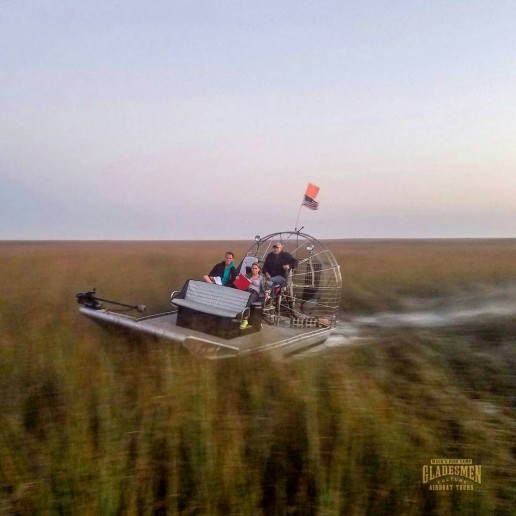
We Gladesmen have been navigating the Everglades by airboat for decades now. We also take pride in sharing it with all who visit it by showing them a fun, exciting, and safe ride. This environment is our home, and we practice proper airboat safety to make sure that all visitors feel at home.
Living with Alligators, A Florida History and How-To
To non-Floridians, the idea of living so close to alligators can sound exciting, scary or just plain wild. The novelty of it can bring unique challenges, too. But much like the endless summer weather, living with alligators is just part of life in Florida.
Alligators all over!
From marshes to rivers and swamps to lakes, alligators have resided throughout Florida for centuries. Spanish settlers & explorers in the 1600’s referred to them as el legarto (“the lizard”), and alligator became the English form of it. Alligators can be found in all 67 counties in Florida.
They’re solitary in nature, and tend to shy away from human contact. But as human populations grow steadily, the potential for interactions often occur. Alligators have been found in neighborhood lakes, backyards, garages, even swimming pools!
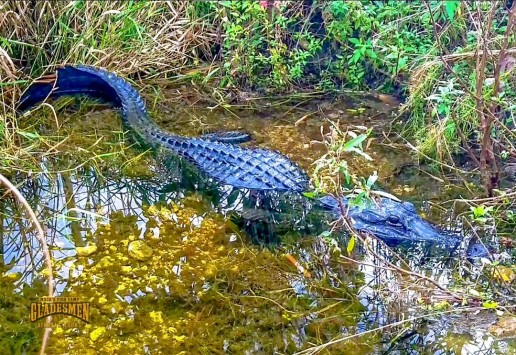
Should you encounter a gator that you believe could pose a nuisance to yourself, your pets, or property, you can call the Nusiance Alligator Hotline at 866-FWC-GATOR (866-392-4286). Alligators under four feet long generally aren’t considered to be a nuisance unless the caller believes it could be a threat. And also keep in mind that, nuisance alligators are killed, not relocated.
Some Alligator Safety Tips
Whether you’re a local living with alligators, or just looking to visit the Sunshine State, here’s some tips to be mindful of regarding gators.
- When camping or fishing, dispose of scraps in trash cans. Don’t discard them in the water, because you may be unintentionally feeding alligators.
- Never feed alligators. Doing so can make the associate people with food and become aggressive.
- Don’t swim outside of designated swimming areas or in waters that might be inhabited by alligators.
- If you’re bitten by an alligator, seek medical attention immediately. Serious infections can result if left untreated.
- And don’t bother alligators. Not only is harassing gators illegal, it can result in injury.
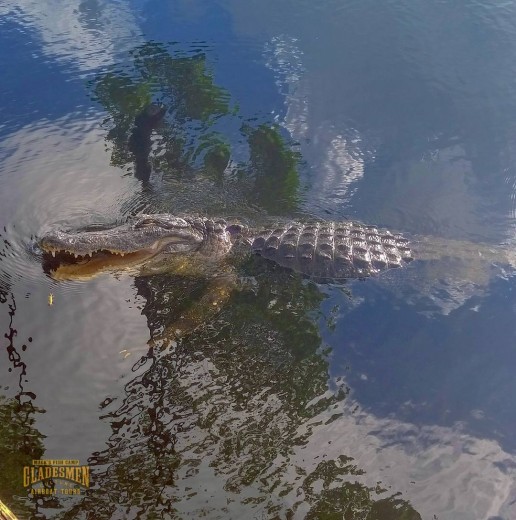
Alligators are a cherished member of not just the Everglades ecosystem, but the state of Florida as a whole. Living with alligators, they seem to pop almost anywhere in the state. But the best place to see them up close is in their natural habitat. Taking an Everglades airboat tour at Mack’s Fish Camp is a fun, safe way to learn about them and the role they place in the environment.
The Benefits and Dangers of Fire in the Everglades
As we reach the end of the Everglades wet season, there’s much to look forward to. Cooler temperatures and decreased rainfall will drive out the mosquitoes and invite migratory and wading birds back to the marshes. But the return of the dry air also brings with it the increased potential of fire in the Everglades.
The 2017 dry season saw some of the most wildfires in years. The state of Florida has had over 2,000 fires so far this year, with 125 fires burning an estimated 31,000 acres through April. The fire in the Everglades was so bad in April that it came right to the doorstep of Mack’s Fish Camp! Thankfully, through the efforts of the Department of Forestry, our historic family home was spared from the encroaching blaze!
Everglades Fires: Friend or Foe?
Despite the hazards fires pose to animal and human Florida residents alike, they can also be beneficial to Everglades ecosystems. For many years, fire in the Everglades has come from lightning strikes and humans. The health of the different Everglades plant species in them relies on the extreme differences between the two seasons here. Just as the summer rains revive the Florida wetlands, fire in the Everglades helps plant life thrive.
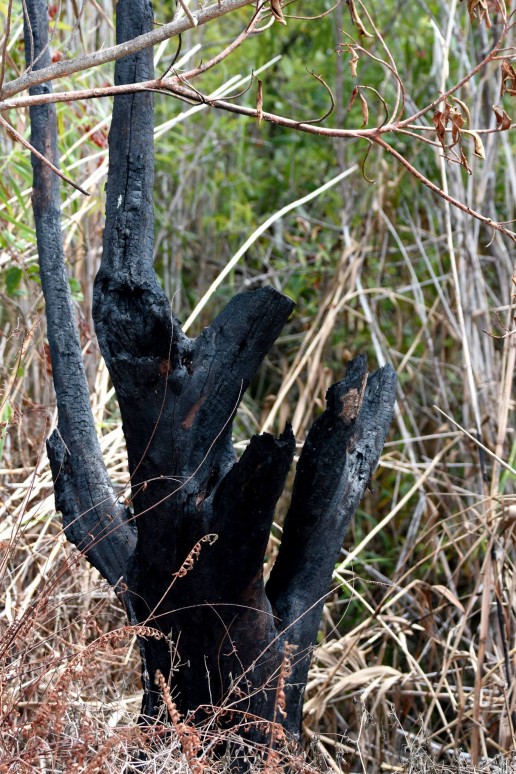
How fire affects different Everglades habitats
The Pine Rocklands habitat has a need for fire that is two-fold. Hammock species of plants that grow there can block sunlight, which can harm smaller plants and even the taller pines. Fires can help clear overgrowth to let all plants thrive, and the extreme heat helps pines seed the ground.
The trees of the Pinelands are very fire-resistant because of their thick bark. The hardwood hammock can withstand fire somewhat, because they sit on wet soil and are very humid. Fires that occur in the coastal prairies are usually started by lightning , and prevent exotic plant encroachment toward freshwater marshes.
The Wet Prairie and Sawgrass Marsh
The habitats where fire is the most vital are the wet prairie and sawgrass marsh. The Everglades is a river, and the main sheet flow moves through these habitats, and is improved by the reduction of sawgrass. Sawgrass fires also burn off flammable plants near tree islands and hardwood hammocks, which are more vulnerable to fire.
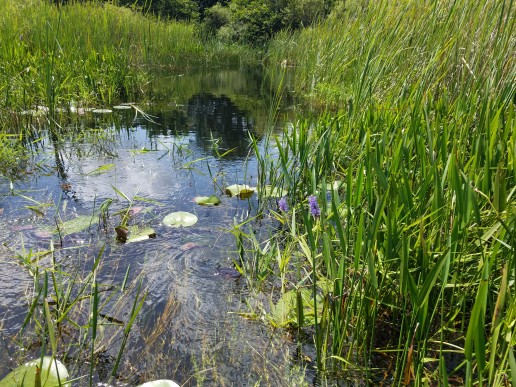
Because of its destructive potential to people and the environment, fire in the Everglades can be quickly written off as a monster. State officials and fire departments keep watch over and fight fires across the state, protecting buildings and the environment alike from them. But fire can also be beneficial to this ecosystem, especially when used in prescribed burns by these officials.
The complexity of the Florida Everglades ecology is a lot to explain, but beautiful to see firsthand on airboat ride. At Mack’s Fish Camp, you can learn about these diverse environments while seeing them up close.
Experience Summer Adventure Year-Round in the Florida Everglades
There are plenty of reasons why South Florida is a popular travel destination. The gorgeous beaches and lively nightlife make visitors balk at the theme parks just over the horizon. A big factor for many tourists is the abundance of warm, sunny weather that seems to last all year. There’s only one experience in South Florida that’s as unique as the climate here: taking an Everglades tour!
Seasons in the Everglades
It definitely feels like summer in Florida for most of the year. But, the Everglades doesn’t really have a summer, or even four distinct seasons, just two! There is the wet season, which lasts from May through November, and the dry season, lasting from December through May. During the Everglades wet season, the Florida wetlands are replenished by heavy rains, and alligators nest and hatch their young. The dry season is defined by little rainfall, and peak activity of several species of Everglades birds like herons and egrets.
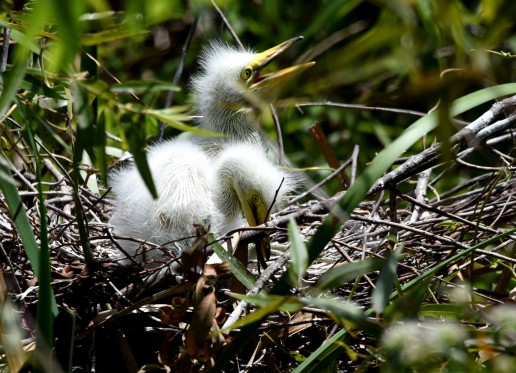
When is the Best time to Visit the Everglades?
The best time to take an Everglades tour can be a matter of preference. The dry season offers cooler temperatures, and the lower water levels and bird nesting concentrate Everglades wildlife into smaller areas. But many tourists visit South Florida at this time, and it gets very busy. During the wet season there are fewer crowds, but also higher temperatures and frequent rain.
Despite there being only two seasons in the Everglades, there are transition periods between them. Starting in October, a noticeable shift starts to occur, the rains become less frequent, and the heat is less intense. Also, a decrease in humidity brings a decrease in pesky, biting mosquitoes!
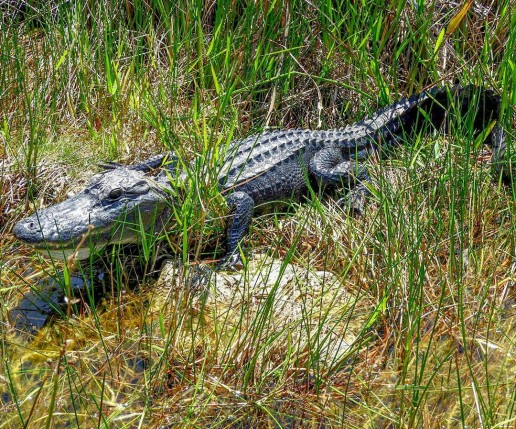
The Everglades wet season can get too hot for some, and the dry season can bring too many people. But, maybe there’s a time of year that’s just right for you. Miami in the fall doesn’t see the leaves changing colors, but the license plates start to! So before the holidays take a bite out of your budget, and snowbirds start arriving from across America and beyond, consider taking an Everglades tour in Miami this fall at Mack’s Fish Camp.
Wildlife Profile: Spiders in the Everglades
Spiders probably aren’t the first animal that comes to mind when you think of the Florida Everglades. But they are among the most abundant of Everglades wildlife, with 20,000 spiders for each of the 2 million acres here. Most of them go about their business unseen, and many are too small to be seen!
Spiders in the Everglades can be found hiding in the underbrush or are easily spotted by the webs they make in trees. Spiders are arachnids, not insects, so they all have eight legs instead of six, no antennae, and their bodies are divided into segments.
As scary as they look to some people, most spiders aren’t a threat to us, and only some are venomous. In fact, spiders are a cherished part of the Everglades food web, feeding on nuisance insects. Here are some species of spider you may spot on an Everglades tour at Mack’s Fish Camp.
Banana Spiders
Banana spiders are the species you’re most likely to see when you visit the Everglades. While the males are smaller and more dark-colored, the more colorful females measure three inches long, and are among the biggest spiders in North America.
These spiders are a type of orbweaver, and spin large circular webs to catch prey. A female’s web is made of golden silk similar to its color, and is three feet long. They feed on insects of all sizes, from mosquitoes to dragonflies. Banana spiders aren’t aggressive, and their bite isn’t harmful to humans.
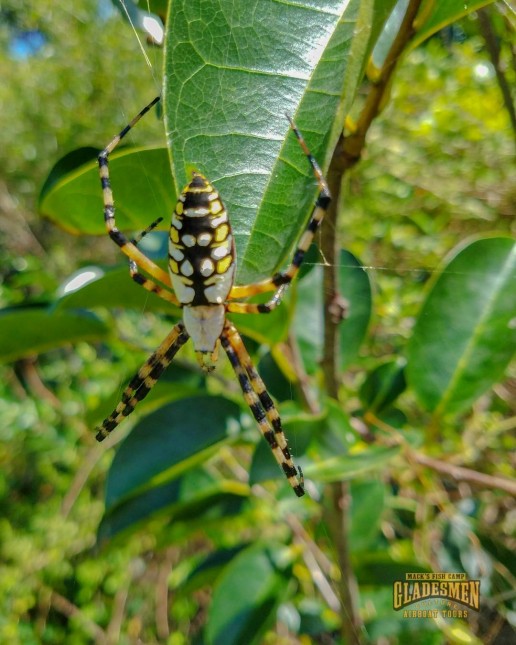
Fishing Spider (dolomedes triton)
This aquatic spider species spends nearly all of its time floating on or near water. In fact, fishing spiders can walk on the water’s surface and even dive underwater to catch prey. They hunt insects, tadpoles, even fish by sensing vibrations in the water, and then eat on dry land. Fishing spiders are dark gray to brown-colored, with two pale lines running the length of their bodies. Because the Everglades is a mostly aquatic ecosystem, fishing spiders are right at home in the sawgrass marshes and wet prairies.
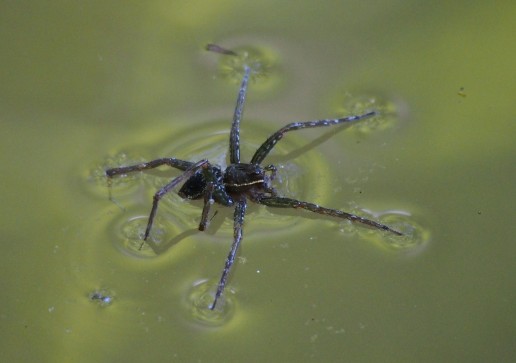
Red Widow
The red widow spider is a venomous spider with an orange-red body and a black abdomen with red spots. They’re fairly large, reaching 1.5 inches in length. Unlike its cousin, the black widow, it hasn’t been known to have ever bitten a person. However, they are known to have very potent venom. Red widows are endemic to Florida, found in the pine scrubs and pine rocklands. They make their nests in saw and scrub palmetto plants, and feed on large insects like crickets.
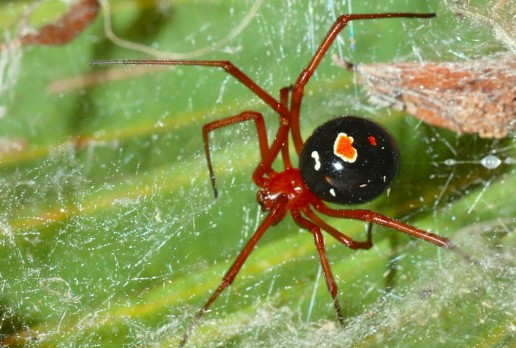
Brown Recluse
The brown recluse is one of the most venomous spiders in the Everglades, with venom as strong as the black widow’s. These quarter-sized arachnids not only make their webs, but seek out prey on the ground, such as cockroaches. Brown recluse spiders are not aggressive, and reports of them biting humans are rare. But they will bite if pressed up against someone’s skin, by leaning into one or when putting on clothing. Although, the strength of their bite varies, it can cause skin damage, loss of limb, and death.
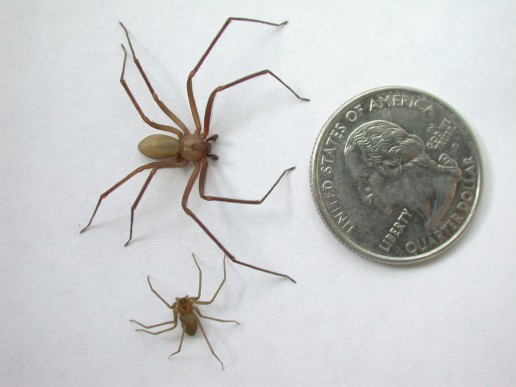
Crab Spiders
These small spiders are named for how they move by scuttling sideways, as a crab would. Most species are dark grey to black to camouflage themselves. Other species are brightly colored to hide inside flowers, wait to ambush their prey. Crab spiders do not spin webs to catch or wrap their prey, but feed immediately after attacking.
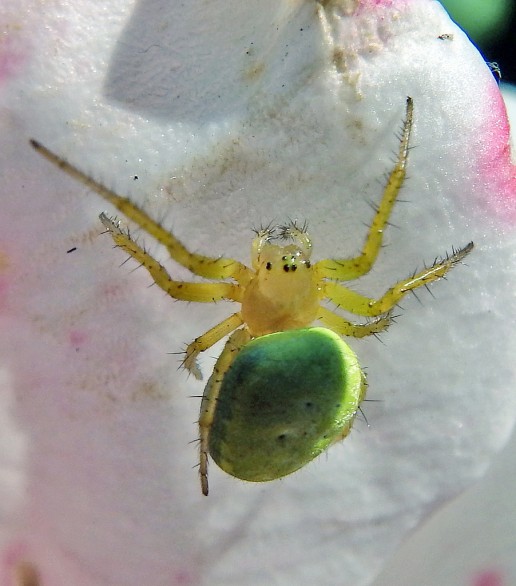
Spot Everglades Wildlife on an Airboat Ride
Spiders in the Everglades serve their role in this ecosystem, no matter how frightening of beautiful you might find them. On a private airboat tour at Mack’s Fish Camp, you’ll get to see them and many other Everglades wildlife species.
5 Ways Hurricanes Can Affect Everglades Wildlife
The arrival of September means the beginning of the end of summer. But for Florida, and several other southern states, it signifies the peak of Atlantic Hurricane season. Hurricane season lasts from June 1st until December 1st, with the most activity usually occurring between late August and mid-October.
Because Florida is a narrow peninsula, The Everglades can feel the effects of a direct hit by a hurricane. Unfortunately, the Everglades wildlife and ecosystem can feel the brunt of the storm as strongly as humans can.
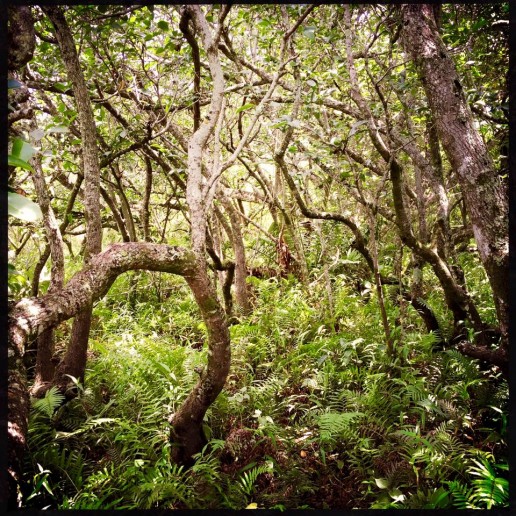
Heavy Rains Can Cause Freshwater Floods
Large amounts of rainfall from hurricanes can flood river basins near coastal areas. The excess water carried along these watersheds could surge into saltwater estuaries. This can offset the balance of saltwater and freshwater, and hurt the ecosystem of the coastal Everglades habitat.
Saltwater Intrusion Caused by Storm Surge
Hurricane winds can be so strong that they cause coastal water to surge far past the shoreline. Along with the flooding damage, the saltwater carried inland can harm freshwater wetland areas. Plants and animals aren’t as salt-tolerant in freshwater marshes and estuaries, and can suffer damage if the seawater doesn’t drain quickly.
High Windspeeds Can Destroy Tree Habitats
Everglades wildlife have specific niches in the diverse habitats here. Powerful hurricane winds can damage hammocks and forests, which not only destroys the animals’ homes, but their food as well. The potent wind gusts can strip berries and nuts from trees.
Storm Winds Can Dislocate Wildlife
The powerful wind fields contained in hurricanes can push birds hundreds of miles off course and far away from their habitats. Some birds get trapped inside the eye of these tropical cyclones, and held there by the extreme winds until it dissipates. Marine mammals like manatees can be blown onshore, too.
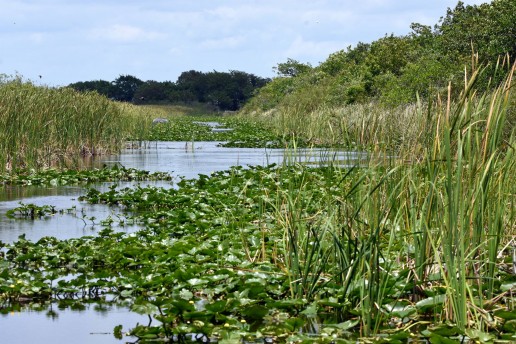
Rough Seas and Storm Winds Harm Marine Wildlife
Storm surge, combined with the rough seas caused by strong winds, are a direct threat to aquatic life. In 1992, Hurricane Andrew killed 182 million fish in the Everglades basin, and nearly 10 million more fish in the waters offshore of Louisiana.
As harsh as Mother Nature can seem to the creatures that live in the Florida Everglades. But, understand that these animals were here long before people, and have adapted to endure all kinds of peril. Taking an airboat eco tour lets you see the varieties of Everglades wildlife that thrive here, much like the tradition of Gladesmen Culture that has been here for generations.
Marjory Stoneman Douglas: Defender of The Everglades
You may know that the Florida Everglades spans over 2 million acres. But did you know that it was once over 11 million acres in size?
That remaining 2 million acres is there thanks in large part to the efforts of Marjory Stoneman Douglas.
After publishing her famous book, “Everglades: River of Grass”, she worked to raise awareness of the Everglades ecosystem. She also pushed back against development in the Everglades, and devoted much of her 108 years to protecting it.
Arrival in Miami
Born April 4, 1880 in Minneapolis, Minnesota, a short and ill-fated marriage got Marjory to reunite with her father in Miami in 1915. Her father was the founding publisher at the Miami’s first newspaper, known today as The Miami Herald. She served in the Navy Reserve during World War I, and was the first woman in Miami to enlist. Marjory left the Herald in 1923 and worked as a freelance writer, which lead to the writing of her most famous work.
The Everglades: River of Grass
While working as a freelance writer in the 1940’s, Marjory was approached to write about the Miami River. As she researched the story, she became fascinated with the Everglades and began researching them too!
In 1947, Marjory published “The Everglades: River of Grass” The book details the system of water flow from the Kissimmee River through Lake Okeechobee into the Everglades. Marjory explained that the Everglades wasn’t the swamp that most people though it was, but a slow-moving river!
From Writer to Conservationist
With the attention and support she received upon the publishing of “River of Grass”, Marjory became directly involved with Everglades conservation. She devoted herself to preserving the sheet flow of the Everglades and educating people all over Florida to be aware of its importance. In doing so, she rallied many to Everglades conservation, which lead to the founding of Friends of the Everglades in 1970, which Marjory was the head of.
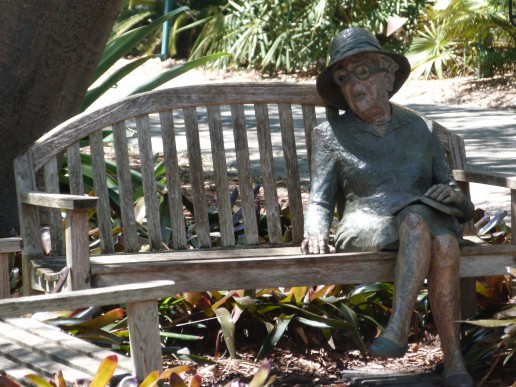
The legacy of the Gladesmen Culture is traditions built upon the marshes and limestone of the Everglades. The passion, commitment, and drive of Marjory Stoneman Douglas forged her legacy, which is the preservation of this ecosystem. Without her tremendous efforts, the Everglades would be just a memory. When you visit Mack’s Fish Camp, we get to share both of our legacies with you.
4 Reasons Why Burmese Pythons Are Overrunning The Everglades
Where does the third largest living snake in the world sit? If it is in Florida, wherever it wants to.
Burmese pythons have earned a reputation for slithering their way to the top of the Everglades food web since their first sightings in the 1980’s. These massive constrictors have become the most notorious invasive species in South Florida, but why? They likely arrived the way most Everglades invasive species do, being released by pet owners or the exotic animal trade.
So, how is this particular invasive seemingly taking over the Everglades ecosystem?
They Reproduce Quickly
Burmese pythons reach maturity between 18 months and 4 years of age, and females can produce a clutch of 35 to 50 eggs or more. They also have a lifespan that can last up to 25 years. With impressive stats like these, it makes their numbers difficult to track.
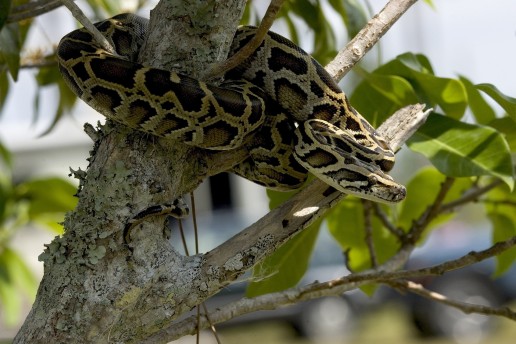
The Everglades Climate is Very Hospitable
There are many invasive species that have adopted the Everglades as their home. Burmese pythons are not only suited for the South Florida climate, but the Everglades ecosystem is like home to them. Originating from the rainy jungles and swamps of southeast Asia, these semi-aquatic creatures are right at home on the River of Grass.
They Are Great At Hiding
By preying on the American alligator, Burmese pythons are now the apex predator of the Everglades. But they have another title that’s helped them thrive as they have: Hide And Seek Champion.
They prefer hiding in underbrush or in holes near rivers, and are also great swimmers. In addition to being able to camouflage themselves, they’re nocturnal. So, their numbers are harder to accurately track, because most recorded sightings are made during the day.
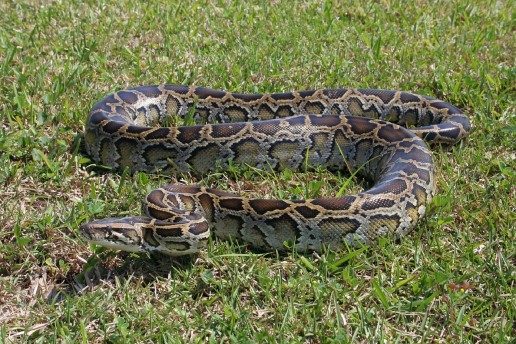
They Are Opportunistic Eaters
You would consider a guest that can eat anything as not being a picky eater. But, if that guest starts eating everything they can, you’d have only your own words to eat. Burmese Pythons have been found to eat a wide variety of Everglades wildlife, including rodents, bobcats, deer, and even alligators!
Their big appetites have like to a steep decline in sightings of rabbits, raccoons, and possums. Because of this, it’s earned the nickname “The snake that’s eating the Everglades”.
South Florida may never be fully rid of these pythons. But, it’s possible that through implementing practical and effective control methods that their population could be managed someday.
When you go for an airboat ride at Mack’s Fish Camp, hopefully you don’t see this Everglades invasive species. While they are shy as most snakes, it could mean trouble for other Everglades wildlife.
Everglades Wildlife Profile: Amphibians
Out of the over 350 animal species living in the Everglades, longer animals like alligators and Burmese pythons get all of the attention, but what about the little guys?
No, not the mosquitoes.
If you look closely, there are frogs, toads, newts and other species of amphibians you can spot on an Everglades eco tour. Amphibians are a class of Everglades wildlife that are as big a part of this environment as wading birds or snakes.
Information About Amphibians
Amphibians are cold-blooded animals that can live on land and in water. In fact, their name comes from the Greek word “amphibios”, which means ”both kinds of life.” When amphibians are young, they spend the first half of their lives solely in the water, then on land after they have physically matured.
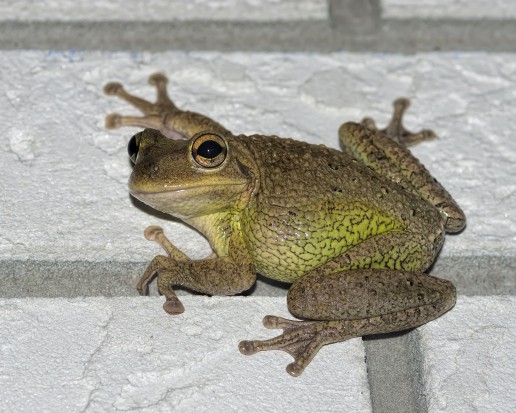
Differences From Reptiles
Unlike reptiles, that prefer to be in or near water, amphibians don’t have a thick outer layer of skin, but a soft thin skin that has to remain wet. Many amphibians can actually breathe through their skin as well as through their lungs.
Amphibians In the Everglades
Residing in wet, humid, and moist habitats, amphibians are a class of Everglades wildlife that are right at home here! Dwelling and nesting near water helps define their role in the Everglades food web. Like their skin, amphibians’ eggs are very soft and need to remain in water. Amphibians and their eggs are a food staple of many Everglades wading birds, like herons and wood storks. But, amphibians feed on insects like mosquitoes, who also lay their eggs in bodies of water.
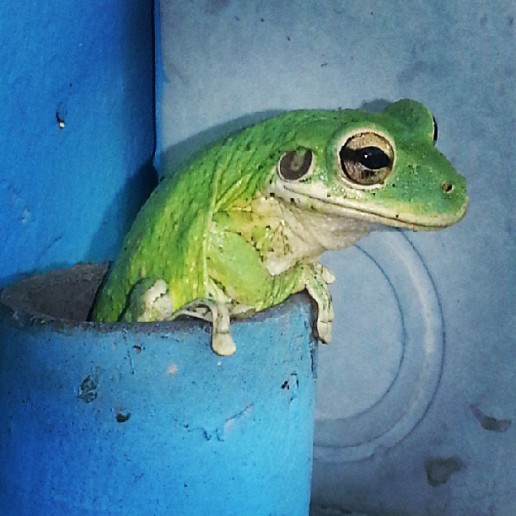
They’re Most Active During Everglades Wet Season
The time of year that amphibians are most active in the Everglades is during the wet season, which lasts from May through November. The abundant moisture and humidity, and the increased activity of insects allow amphibians to thrive. No matter how many frogs and toads you might see, you’ll hear hundreds more croaking and chirping.
The best way to see amphibians like the green tree frog, everglades dwarf siren, and the many other species of Everglades wildlife here is on an airboat ride. On an everglades eco tour, you can observe the biodiversity of this unique environment while learning from true-born Gladesmen that have lived here for generations.
4 Everglades Animals People Haven't Heard Of
Of the many species of wildlife that live in the Everglades, there are only a few that are well-known. The American alligator, Florida panther, and many wading bird species are the first animals people associate with the Florida Everglades. There are also several other Everglades animals native to Florida that make their home here as well, but are overlooked. Here are four of these Everglades hometown heroes.
Everglades Snail Kite
This medium-sized bird of prey differs from other raptors, as it feeds on mollusks, primarily snails. Snail kites are easily identified by their slender, curved bills, which help them to easily extract apple snails, their primary prey, from their shells. Their very specific diet depends upon the water levels and water quality of the Everglades, and they are listed as endangered due to habitat degradation affecting apple snail populations.
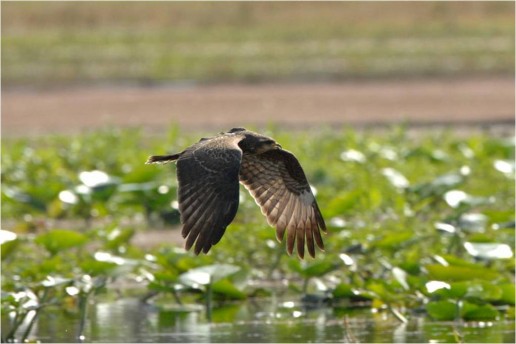
Florida Black Bear
The only species of bear found in Florida, the Florida black bear has adapted to living in a subtropical habitat. It mostly thrives on acorns, palmetto berries, nuts, and holly as well as colonial insects like ants, termites, bees, and wasps. During their breeding season in the summer, black bears consume 5000 calories a day! Florida black bears favor habitats that have a dense understory, and can be found in the forested sloughs, oak scrubs, pine rocklands, and other wooded areas in the Everglades.
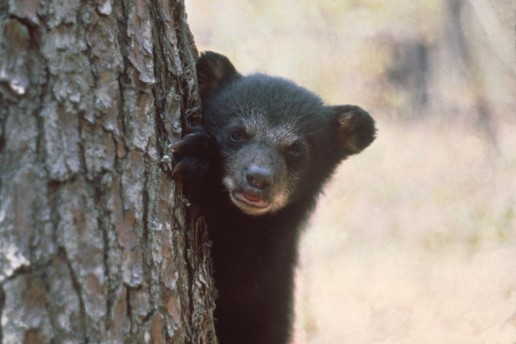
American Purple Gallinule
This colorful bird is found in marshes throughout the tropics, but it’s only year-round residence in America is the Florida Everglades. Named for its mostly purple feathers, its green back, red and yellow bill, blue forehead and long, yellow legs make it a walking rainbow. The purple gallinule also has very long toes to allow it to walk on lily pads and floating vegetation without sinking.
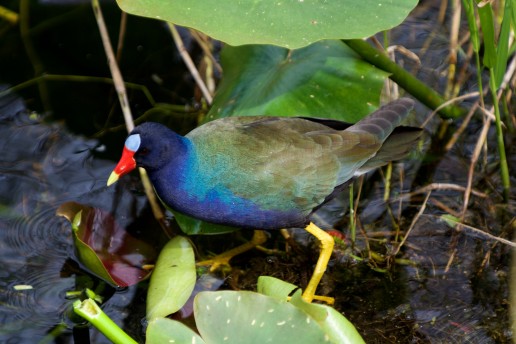
Everglades Mink
One of three species of mink living in Florida, the Everglades mink can be found in swamps and freshwater marshes. These aquatic mammals are nocturnal hunters and fierce fighters, capable of attacking prey larger than them. Everglades mink activity has been observed to increase before storms and other changes in weather.
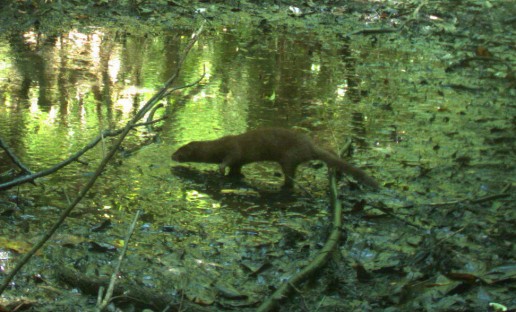
These Everglades animals might not have the star power that alligators and roseate spoonbills do, but their uniqueness to the Florida Everglades makes them equally as important. When you take a private airboat tour at Mack’s Fish Camp, you get a chance to see the magnificent creatures in their natural habitat. Like the Gladesmen Culture that has thrived here for generations, so do countless animal species.

